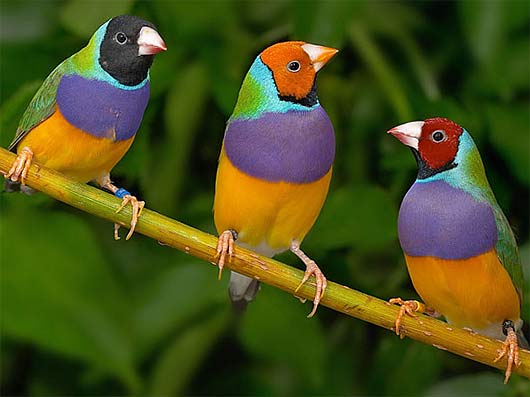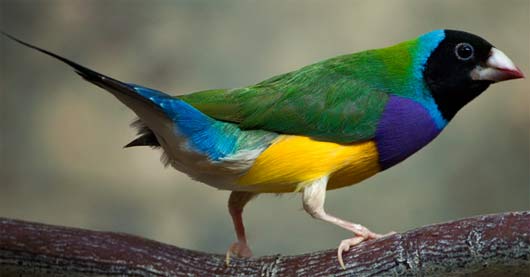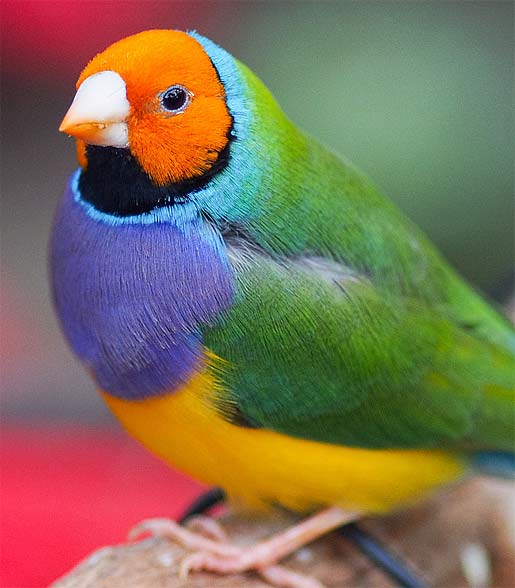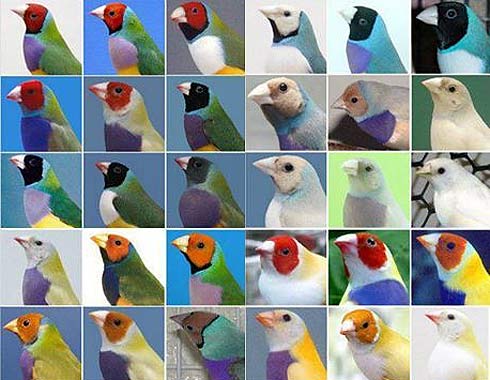Gouldian Finch – Colorful Bird of Australian Grassy Tropics

The Gouldian finch is a brightly colored, endangered bird from northern Australia. It is not just splendid colors that make the this bird stand out but also the bold pattern and improbable design of the plumage. Interestingly, the bird also comes in three color variants. All females and most males have smart black hoods, but a consistent minority, about a quarter of all males have red heads, and one in 100 has an orange head. Nobody has yet worked out why these color morphs occur. Captive breeding has generated a whole slew of other color mutations and some put the bird near the top of the beautiful bird list!

The species was first discovered by the English naturalist and explorer John Gould in 1844 and he named it in honor of his wife and so it is also known as the Lady Gouldian. At the time, it was an abundant bird of grassy areas of the tropical north, and was regularly seen in flocks of thousands. Now a thing of the past, it is hard to imagine what a spectacular sight they must have made.

The Gouldian finch is very much a bird of hot, sunny climates; experiments have shown that its activity begins to peak at about 100 degrees F (38 degrees). If the temperature passes 107 degrees, the heat begins to be a bit much and the bird calms down a bit. For breeding, it depends on the rains, which bring about the required abundant growth of seeding grasses, a vital component of its habitat. This makes it a bit fussy ecologically, needing just the right balance of sun and rain to breed. In some areas it may make a short migration to find the perfect location.

The nest site chosen by this bird is highly unusual for an Australian finch. Most of its relatives place their domed, grass structures in thick, thorny bushes, but the Gouldian finch builds inside a cavity, either a hole in a tree or a crevice in a termite mound. The young hatch in the dark, their begging facilitated by iridescent nodules flanking their gaping mouths, reflecting light to guide the parents to the waiting jaws. Although they eat some insects, and have been recorded launching into the air to snap up flying termites, they are primarily seed-eaters. This is a very dry diet and, in contrast to most small birds, they are able to suck up water. It is thought that this could be an adaptation to drinking from very small, shallow water sources.
Although grass does not sound like that tough of an ecological requirement, what it needs is really specific: open woodland with abundant grass underneath. It seems that this depends upon a regime of infrequent but regular fires. In recent years, unfortunately for the finch, the fires have been too regular, resulting in a tipping of the balance towards unsuitable habitat. This, together with the fact that cattle-grazing prevents the grass from seeding, has suddenly made the Gouldian finch’s precise habitat very scarce. And this is bad news. Already suffering from many years of trapping for the cage-bird trade, difficulties in the wild have sent the population into a sharp decline. Suddenly this bird is not just scarce, but endangered. The numbers are frighteningly small and, ironically, it may be that only captive-breeding, together with strict management, can save this bird for the future.

